Neuroblast lineage-specific origin of the neurons of the Drosophila larval olfactory system
- PMID: 23149077
- PMCID: PMC4045504
- DOI: 10.1016/j.ydbio.2012.11.003
Neuroblast lineage-specific origin of the neurons of the Drosophila larval olfactory system
Abstract
The complete neuronal repertoire of the central brain of Drosophila originates from only approximately 100 pairs of neural stem cells, or neuroblasts. Each neuroblast produces a highly stereotyped lineage of neurons which innervate specific compartments of the brain. Neuroblasts undergo two rounds of mitotic activity: embryonic divisions produce lineages of primary neurons that build the larval nervous system; after a brief quiescence, the neuroblasts go through a second round of divisions in larval stage to produce secondary neurons which are integrated into the adult nervous system. Here we investigate the lineages that are associated with the larval antennal lobe, one of the most widely studied neuronal systems in fly. We find that the same five neuroblasts responsible for the adult antennal lobe also produce the antennal lobe of the larval brain. However, there are notable differences in the composition of larval (primary) lineages and their adult (secondary) counterparts. Significantly, in the adult, two lineages (lNB/BAlc and adNB/BAmv3) produce uniglomerular projection neurons connecting the antennal lobe with the mushroom body and lateral horn; another lineage, vNB/BAla1, generates multiglomerular neurons reaching the lateral horn directly. lNB/BAlc, as well as a fourth lineage, vlNB/BAla2, generate a diversity of local interneurons. We describe a fifth, previously unknown lineage, BAlp4, which connects the posterior part of the antennal lobe and the neighboring tritocerebrum (gustatory center) with a higher brain center located adjacent to the mushroom body. In the larva, only one of these lineages, adNB/BAmv3, generates all uniglomerular projection neurons. Also as in the adult, lNB/BAlc and vlNB/BAla2 produce local interneurons which, in terms of diversity in architecture and transmitter expression, resemble their adult counterparts. In addition, lineages lNB/BAlc and vNB/BAla1, as well as the newly described BAlp4, form numerous types of projection neurons which along the same major axon pathways (antennal tracts) used by the antennal projection neurons, but which form connections that include regions outside the "classical" olfactory circuit triad antennal lobe-mushroom body-lateral horn. Our work will benefit functional studies of the larval olfactory circuit, and shed light on the relationship between larval and adult neurons.
Copyright © 2012 Elsevier Inc. All rights reserved.
Figures

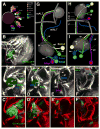
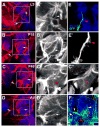

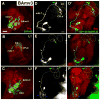
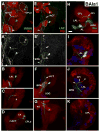

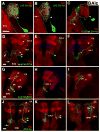
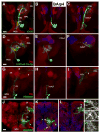

Similar articles
-
Drosophila olfactory local interneurons and projection neurons derive from a common neuroblast lineage specified by the empty spiracles gene.Neural Dev. 2008 Dec 3;3:33. doi: 10.1186/1749-8104-3-33. Neural Dev. 2008. PMID: 19055770 Free PMC article.
-
Adult-like complexity of the larval antennal lobe of D. melanogaster despite markedly low numbers of odorant receptor neurons.J Comp Neurol. 2002 Apr 15;445(4):374-87. doi: 10.1002/cne.10188. J Comp Neurol. 2002. PMID: 11920714
-
Diversity, variability, and suboesophageal connectivity of antennal lobe neurons in D. melanogaster larvae.J Comp Neurol. 2011 Dec 1;519(17):3415-32. doi: 10.1002/cne.22713. J Comp Neurol. 2011. PMID: 21800296
-
Olfactory coding in the mosquito antennal lobe: labeled lines or combinatorial code?Curr Opin Insect Sci. 2025 Apr;68:101299. doi: 10.1016/j.cois.2024.101299. Epub 2024 Nov 15. Curr Opin Insect Sci. 2025. PMID: 39550060 Review.
-
The role of the Drosophila lateral horn in olfactory information processing and behavioral response.J Insect Physiol. 2017 Apr;98:29-37. doi: 10.1016/j.jinsphys.2016.11.007. Epub 2016 Nov 19. J Insect Physiol. 2017. PMID: 27871975 Review.
Cited by
-
Dynamical feature extraction at the sensory periphery guides chemotaxis.Elife. 2015 Jun 16;4:e06694. doi: 10.7554/eLife.06694. Elife. 2015. PMID: 26077825 Free PMC article.
-
Internal state configures olfactory behavior and early sensory processing in Drosophila larvae.Sci Adv. 2021 Jan 1;7(1):eabd6900. doi: 10.1126/sciadv.abd6900. Print 2021 Jan. Sci Adv. 2021. PMID: 33523854 Free PMC article.
-
Hydroxyurea-mediated neuroblast ablation establishes birth dates of secondary lineages and addresses neuronal interactions in the developing Drosophila brain.Dev Biol. 2015 Jun 1;402(1):32-47. doi: 10.1016/j.ydbio.2015.03.005. Epub 2015 Mar 13. Dev Biol. 2015. PMID: 25773365 Free PMC article.
-
Postembryonic lineages of the Drosophila brain: I. Development of the lineage-associated fiber tracts.Dev Biol. 2013 Dec 15;384(2):228-57. doi: 10.1016/j.ydbio.2013.07.008. Epub 2013 Jul 20. Dev Biol. 2013. PMID: 23880429 Free PMC article.
-
Developmental experience-dependent plasticity in the first synapse of the Drosophila olfactory circuit.J Neurophysiol. 2016 Dec 1;116(6):2730-2738. doi: 10.1152/jn.00616.2016. Epub 2016 Sep 28. J Neurophysiol. 2016. PMID: 27683892 Free PMC article. Review.
References
-
- Axel R. The molecular logic of smell. Sci Am. 1995;273:154–159. - PubMed
-
- Brochtrup A, Hummel T. Olfactory map formation in the Drosophila brain: genetic specificity and neuronal variability. Curr Opin Neurobiol 2010 - PubMed
-
- Carlsson MA, Diesner M, Schachtner J, Nassel DR. Multiple neuropeptides in the Drosophila antennal lobe suggest complex modulatory circuits. J Comp Neurol. 2010;518:3359–3380. - PubMed
Publication types
MeSH terms
Grants and funding
LinkOut - more resources
Full Text Sources
Other Literature Sources
Molecular Biology Databases

